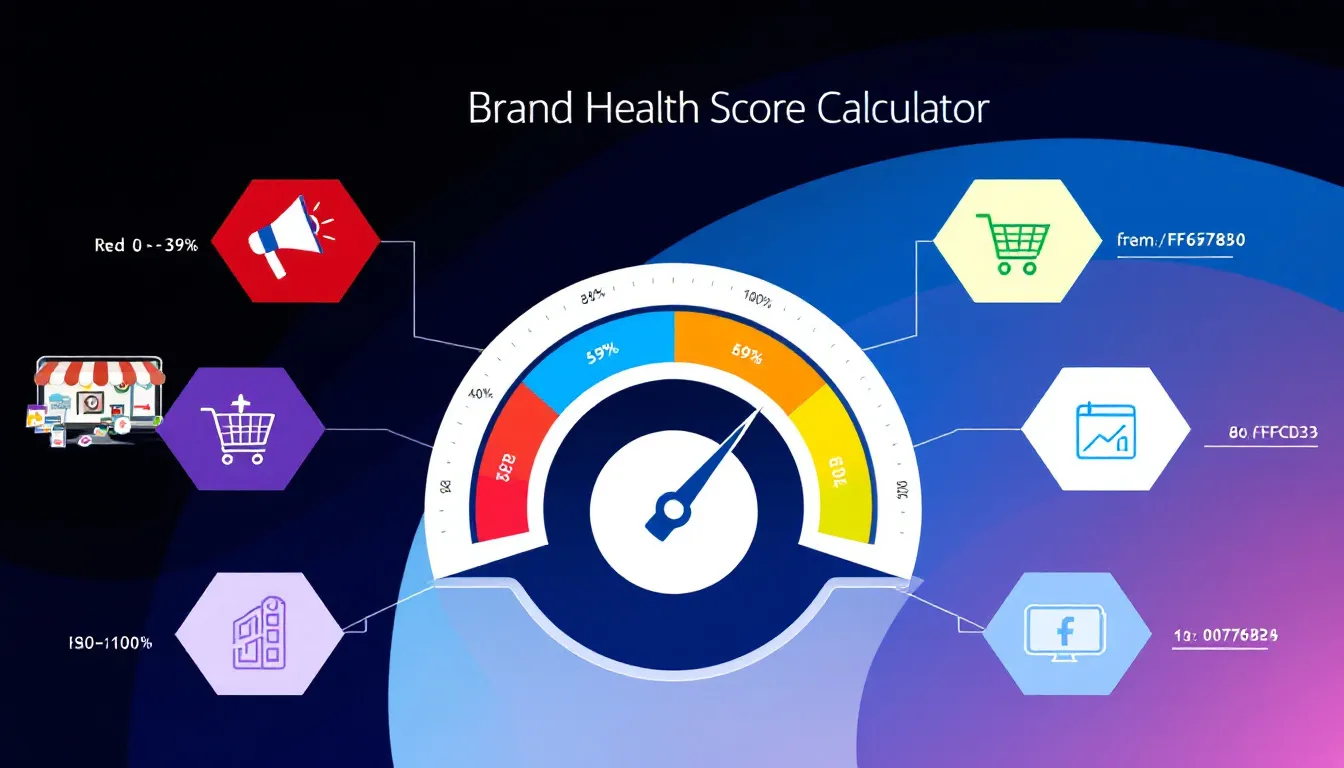Is this tool helpful?
How to Use the Brand Health Score Calculator Effectively
This Brand Health Score Calculator helps you measure key brand performance metrics and assess your overall brand strength. Enter the values below to receive a comprehensive score and clear insights into your brand’s current market status.
- Brand Awareness Score (%): Enter the percentage of your target audience familiar with your brand. For example, if 600 out of 1,200 respondents recognize your brand, input 50%. Or if 920 out of 1,000 are aware, enter 92%.
- Brand Consideration Score (%): Input the percentage of potential customers who would consider buying from your brand. For instance, if 360 out of 900 consider your brand, enter 40%. Or if 540 out of 1,200 respond positively, enter 45%.
- Brand Preference Score (%): Enter the share of consumers preferring your brand over competitors. If 250 out of 700 prefer your brand, input 35.7%. Alternatively, if 400 out of 1,000 prefer your brand, type 40%.
- Brand Loyalty Score (%): Enter the percentage of customers who return for repeat purchases. For example, if 210 out of 300 customers are repeat buyers, input 70%. Or if 390 out of 600 customers are loyal, enter 65%.
- Net Promoter Score (NPS): Enter your customer loyalty and referral metric, ranging from -100 to +100. For example, enter 20 or 60 based on your survey results.
- Customer Satisfaction Score (CSAT) (%): Input your overall customer satisfaction rate. For instance, enter 75% or 88%.
- Brand Equity Score: Enter your brand equity numeric score reflecting brand value.
- Maximum Brand Equity Score: Input the highest possible brand equity value for standardization, such as 100 or 120.
What Is the Brand Health Score Calculator and How It Benefits You
The Brand Health Score Calculator is an interactive tool designed to quantify your brand’s performance based on multiple crucial metrics. It gathers inputs like brand awareness, consideration, preference, loyalty, customer satisfaction, Net Promoter Score (NPS), and brand equity. Then, it calculates a weighted overall health score giving you a clear picture of your brand’s market position.
By using this calculator, you get reliable, standardized insights that help you:
- Assess your brand’s strengths and weaknesses across key performance areas.
- Visualize your metrics with easy-to-understand bar and radar charts.
- Track improvements or declines in brand perception over time.
- Make data-driven decisions to boost marketing and customer engagement strategies.
- Set realistic goals for enhancing brand equity and customer loyalty.
Example Calculation of Brand Health Score
This calculator combines your inputs using a weighted average formula to produce the Brand Health Score. The formula looks like this:
The score factors percentages of by metric and applies weights based on their importance.
Using MathJax 3, the formula is:
$$\text{Brand Health Score} = (BA \times 0.20) + (BC \times 0.15) + (BP \times 0.15) + (BL \times 0.20) + (NPS_s \times 0.15) + (CSAT \times 0.10) + (BE_s \times 0.05)$$
Where:
- BA = Brand Awareness Score (%)
- BC = Brand Consideration Score (%)
- BP = Brand Preference Score (%)
- BL = Brand Loyalty Score (%)
- NPS_s = Standardized Net Promoter Score (%)
- CSAT = Customer Satisfaction Score (%)
- BE_s = Standardized Brand Equity Score (%)
Standardizing NPS and Brand Equity
Before combining into the health score, the Net Promoter Score and Brand Equity must be standardized to % scales:
Standardized NPS formula:
$$\text{Standardized NPS} = \dfrac{NPS + 100}{200} \times 100$$
Standardized Brand Equity formula:
$$\text{Standardized Brand Equity} = \dfrac{\text{Brand Equity Score}}{\text{Maximum Brand Equity Score}} \times 100$$
Benefits of the Brand Health Score Calculator for Your Business
- Provides a comprehensive, multi-metric evaluation of brand health.
- Offers clear visual feedback via intuitive bar and radar charts.
- Applies standardized scoring for consistent performance tracking.
- Helps identify specific areas that need immediate improvement.
- Makes it easier to benchmark your brand against competitors or industry averages.
- Supports strategic marketing decisions grounded in data analytics.
Practical Usage and Example Scenarios
Scenario 1: Emerging Consumer Brand
Input values:
- Brand Awareness: 55%
- Brand Consideration: 42%
- Brand Preference: 30%
- Brand Loyalty: 60%
- NPS: 15
- CSAT: 78%
- Brand Equity: 50 (max: 100)
Calculated Brand Health Score: 52.6% (Average performance)
Scenario 2: Mature Service Brand
Input values:
- Brand Awareness: 90%
- Brand Consideration: 75%
- Brand Preference: 55%
- Brand Loyalty: 80%
- NPS: 40
- CSAT: 88%
- Brand Equity: 90 (max: 100)
Calculated Brand Health Score: 79.3% (Good to excellent performance)
Interpreting Your Brand Health Score and Next Steps
Score Ranges
- 80-100% (Excellent): Your brand performs strongly across all metrics and is well positioned.
- 60-79% (Good): Solid brand health with opportunities to optimize and grow.
- 40-59% (Average): Moderate performance—plan improvements in weaker areas.
- Below 40% (Poor): Urgent action needed to address major brand challenges.
Recommended Actions Based on Score Components
- Low Brand Awareness: Increase marketing efforts and brand visibility through advertising and social media campaigns.
- Low Brand Consideration: Improve messaging about your product’s value and benefits to attract consideration.
- Low Brand Preference: Differentiate your brand features and focus on unique selling points.
- Low Brand Loyalty: Enhance customer experience and implement retention programs.
- Low NPS: Collect customer feedback, address concerns, and build loyalty.
- Low CSAT: Focus on product quality improvements and responsive customer support.
- Low Brand Equity: Strengthen brand positioning, perception, and emotional connection.
Frequently Asked Questions About Brand Health Score
What is a good Brand Health Score?
A Brand Health Score above 60% signals good brand strength. Scores exceeding 80% indicate excellent brand performance, but you should also consider your industry context and competitors when interpreting results.
How often should I measure my Brand Health Score?
Measuring quarterly is ideal for most businesses. Monthly tracking helps brands undergoing rapid change or launching new campaigns to monitor shifts closely.
Can I customize the metric weightings in the calculation?
This calculator uses preset weights based on industry standards, but you can tailor your own calculations internally to reflect strategic priorities or specific business goals.
Where do I collect data to complete the calculator?
Gather data via customer surveys, market research reports, sales statistics, customer service feedback, and brand tracking studies.
What should I do if my Brand Health Score is low?
Focus first on the lowest scoring metrics. Develop targeted plans to improve those areas and track progress consistently to see meaningful brand growth.
How does Brand Health Score relate to business outcomes?
Stronger Brand Health Scores typically correlate with higher customer acquisition, better retention, and increased revenue growth, making it a valuable performance indicator.
Maximizing the Value of Your Brand Health Score
Best Practices for Ongoing Success
- Track your Brand Health Score regularly to monitor trends and changes.
- Compare your results with industry benchmarks and competitors.
- Set clear, achievable goals based on score insights.
- Create specific improvement plans targeting weak metrics.
- Engage your team and stakeholders with score findings to drive shared accountability.
- Document lessons learned and use data to guide strategic decisions.
Aligning Brand Health with Business Strategy
- Connect your brand health objectives with wider business goals.
- Use insights to inform and optimize your marketing strategy.
- Allocate resources based on where metrics show the most opportunity.
- Develop targeted campaigns to improve specific brand dimensions.
- Establish ownership for brand health metrics within your organization.
Important Disclaimer
The calculations, results, and content provided by our tools are not guaranteed to be accurate, complete, or reliable. Users are responsible for verifying and interpreting the results. Our content and tools may contain errors, biases, or inconsistencies. Do not enter personal data, sensitive information, or personally identifiable information in our web forms or tools. Such data entry violates our terms of service and may result in unauthorized disclosure to third parties. We reserve the right to save inputs and outputs from our tools for the purposes of error debugging, bias identification, and performance improvement. External companies providing AI models used in our tools may also save and process data in accordance with their own policies. By using our tools, you consent to this data collection and processing. We reserve the right to limit the usage of our tools based on current usability factors.







